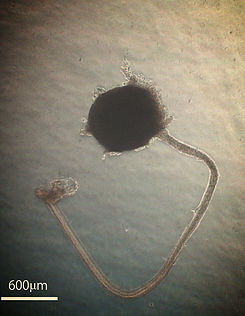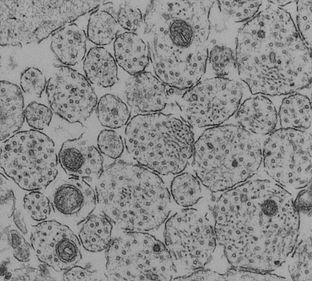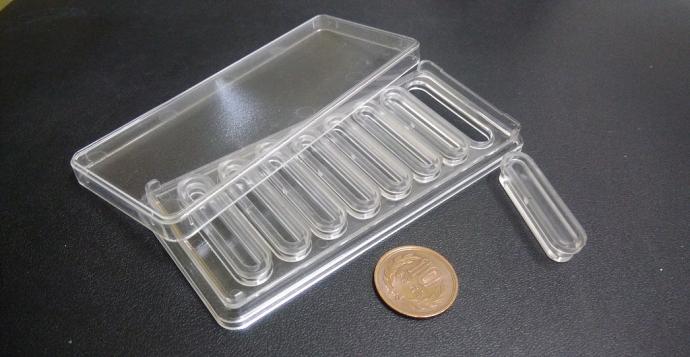ここから本文です。
株式会社Jiksak Bioengineering(京都企業紹介)Jiksak Bioengineering Co., Ltd.
『ALS創薬に挑む!』神経難病の解決にオルガノイドで貢献するベンチャーの挑戦 “Taking on the challenge of ALS drug discovery! ” A venture venture that contributes to solving intractable neurological diseases with organoids
ALS ― 筋萎縮性側索硬化症は、神経難病のひとつ。手足や舌の筋肉、呼吸に必要な筋肉などが痩せて力がなくなっていく病気である。著名人も参加した「アイスバケツチャレンジ」がSNSで話題となったが、この難病は、原因が未だ解明されておらず、完治する治療法は現在存在しない。
この難病を、iPS細胞を使った独自の細胞培養法「Nerve organoid」で解決を目指すベンチャー企業「Jiksak Bioengineering(外部リンク)」代表の川田社長にお話を伺った。
ALS - Amyotrophic lateral sclerosis is an incurable neurological disease. It is a disease in which the muscles of the limbs, tongue, and muscles necessary for breathing become thin and lose strength. The ``Ice Bucket Challenge,'' which celebrities also participated in, became a hot topic on social media, but the cause of this incurable disease is still unknown, and there is currently no cure. We spoke with President Kawata of Jiksak Bioengineering, a venture company that aims to solve this incurable disease using a unique cell culture method called ``Nerve organoid'' using iPS cells.
ALSの怖さ。少しでも早く産業応用を The fear of ALS. Industrial application as soon as possible
--まずは、起業のきっかけ、ALSを研究されることとなった経緯を教えてください。First of all, please tell us how you started your business and how you came to research ALS.
川田)元々は、治療や再生医療というよりは、細胞を用いたマイクロ流体デバイスの研究をしていました。在学中に米国へ留学したことがひとつの契機になりました。そこで目の当たりにしたのは、アメリカでは研究者がどんどんベンチャー企業を立ち上げてチャレンジしている。数も日本とは比べ物にならない。これでは日本は本当に危険というか、どんどん世界に置いていかれるなと思い、いち早く自身の研究を産業展開したいと思ったことが起業のきっかけです。
留学中に運動神経の研究に取り組んだこともあり、ALSの病気のことを知る機会がありました。ALSは、本当に怖ろしい病気です。患者さんや研究者の本をきっかけに、ALSが想像以上に辛くおそろしい病気だと知りました。「ALSという難病の解決に貢献したい」と考えるようになり、日本に戻ってからはALS研究に没頭しました。
Originally, I was researching microfluidic devices using cells rather than treatment or regenerative medicine. One of the opportunities for me was to study abroad in the United States while I was in college. What I witnessed there was that in the United States, more and more researchers were starting venture companies and taking on new challenges. The number is also incomparable to Japan. I thought that this was really dangerous for Japan, and that Japan was being left behind by the rest of the world, and I wanted to be the first to develop my research into industry, which is what led me to start my own company. While studying abroad, I was involved in research on motor nerves, which gave me the opportunity to learn about ALS. ALS is a truly scary disease. Through reading books written by patients and researchers, I learned that ALS is a more painful and frightening disease than I had imagined. I started thinking, ``I want to contribute to solving the incurable disease ALS,'' and after returning to Japan, I devoted myself to ALS research.
--川田社長にとってALS(の怖さ)とはどのようなものでしょうか。President Kawada, what kind of fear is ALS?
川田)「閉じ込められる」という表現があっているかどうかはわかりませんが、私はそう感じました。ALSは、手足や舌などの筋肉の力がだんだんなくなっていきます。しかし、筋肉そのものの病気ではなく、筋肉を動かし、運動をつかさどる神経(運動ニューロン)だけが障害をうけます。その一方で、体の感覚、視力や聴力などは保たれることが普通です。つまり、「運動神経は使えなくなるが、感覚や感情は今まで通り」です。意識があるのにそれを誰かに伝えたり、表情やジェスチャーを含めて表現できない、本当に怖い難病です。研究が進み、ALSの原因については様々な仮説の論文が出てきましたが、明確な原因がわかっておらず、根治療法もありません。
I don't know if there's an expression for "being trapped," but that's how I felt. In ALS, muscle strength in the limbs, tongue, etc. gradually decreases. However, it is not a disease of the muscles themselves; only the nerves (motor neurons) that move the muscles and control movement are affected. On the other hand, physical sensations, vision, and hearing are usually preserved. In other words, ``you will no longer be able to use your motor nerves, but your senses and emotions will remain the same.'' It is a truly scary and incurable disease in which people are conscious but are unable to communicate this to others or express it through facial expressions or gestures. As research progresses, various papers have emerged with various hypotheses regarding the cause of ALS, but the exact cause is still unknown and there is no cure.
--ベンチャーの創業には資金を含めて様々な課題・ハードルがあると聞きますが、川田社長はどのようにそれを乗り越えたのでしょうか。I hear that starting a venture comes with various challenges and hurdles, including funding, but how did President Kawada overcome them?
川田)ポスドク(博士後研究員)時代には、本業の研究の傍らで、産業への展開を目指して動いていました。たくさんの方とお会いする中で、出資をいただけるVCがようやく見つかった。こうしたパートナー探しは、ベンチャー創業にとって、とても重要です。そして、NEDOのSUI採択案件(研究開発型ベンチャー支援事業)にも選ばれたことで、ベンチャー企業の創業に踏み切ったのが、2017年の2月です。
During my time as a postdoctoral researcher, I was working alongside my main research work with the aim of expanding into industry. After meeting with many people, we finally found a VC who could invest in us. Finding a partner like this is very important for starting a venture. In February 2017, we decided to start a venture company after being selected as a NEDO SUI project (research and development venture support project).
人体構造を再現する従来の細胞培養ではない革新的な手法 An innovative method other than traditional cell culture to reproduce human body structure
--御社のコア技術である「Nerve organoid」とは、どのような技術でしょうか。What kind of technology is "Nerve organoid", which is your company's core technology?
川田)人工的に、人体と同じような神経をつくることができたら、ALSの治療法や薬の探索が進むだろうなと考え、チャレンジしたのがNerve organoidです。患者さんの体の中の病態再現、ALSの運動神経そのものをつくるというものです。
I thought that if we could artificially create nerves similar to those in the human body, the search for treatments and drugs for ALS would advance, so I took on the challenge of creating nerve organoids. The idea is to recreate the pathological condition inside the patient's body and create the exact motor nerves of ALS.

【Nerve organoidの写真(Jiksak Bioengineering HPより)】
--もう少し詳しく教えてください。近年は様々なバイオベンチャーが立ち上がり、心筋や神経細胞を作製する企業も多くなってきました。他社との差別化要素はどのあたりにあるのでしょうか。Please tell me more details. In recent years, various bio-ventures have been launched, and more and more companies are producing cardiac muscle and nerve cells. What are the elements that differentiate you from other companies?
川田)神経の作製方法です。我々の技術では、神経の細胞体と軸索(神経繊維)をきちんと分けて観察することができます。そもそも、人間の運動神経は、軸索が束になってまとまって延びています。しかし、従来の細胞培養では、細胞体と軸索が混ざっており、体内をきちんと再現できていないので、細胞体や軸索を分けてタンパク質やRNAを詳細に測定できません。
元々研究していたマイクロ流体デバイスの仕組みを活用し、iPS細胞から作製したこの神経組織とかけあわせて、細胞体と軸索が分かれた“模擬神経デバイス”を自社独自の技術として確立したことが強みだと思います。
This is a method for creating nerves. Our technology allows us to clearly separate and observe nerve cell bodies and axons (nerve fibers). To begin with, human motor nerves are made up of axons that extend in bundles. However, in conventional cell culture, cell bodies and axons are mixed together, and the inside of the body cannot be reproduced properly, so it is not possible to separate cell bodies and axons and measure proteins and RNA in detail. By utilizing the microfluidic device mechanism that we had originally researched and combining it with this neural tissue created from iPS cells, we were able to establish a "simulated neural device" with separate cell bodies and axons as our own proprietary technology. I think it's a strength.


【軸索解析に特化した神経組織(Jiksak Bioengineering HPより)】
--いわゆる 「organ on a chip(人工臓器チップ)」の考え方ですね。This is the so-called "organ on a chip" concept.
川田)私自身はマイクロデバイスの研究者なので、「人工臓器チップ」には注目しています。これは、チップの中に心筋や神経、肝臓など様々な細胞組織を詰めて流路で繋げる技術で、チップを連結していわば模擬人体をつくるという考えです。日本でも、世界でも、人工臓器チップを用いた研究が既に少なからず進んでいますし、今後は創薬や化合物のテストなどで活用されていくと思います。
Since I am a microdevice researcher myself, I am paying attention to "artificial organ chips." This is a technology in which various cell tissues such as heart muscle, nerves, and liver are packed inside a chip and connected through channels, and the idea is to connect the chips to create a simulated human body. Research using artificial organ chips is already well underway both in Japan and around the world, and I think they will be used in drug discovery and compound testing in the future.

【Nerve Organoid chip】
--この技術を用いることで、新たにできるようになった研究などはあるのでしょうか。Is there any new research that has become possible by using this technology?
川田)様々なことができるようになりました。先ほど、従来の細胞培養は「何もかもが混在している」という話をしましたが、細胞体と軸索を分けて観察できることで、軸索だけを取り出してその変化を分析したり、軸索と他の細胞組織をミックスさせることで、より人体に近い分析ができると思います。例えば、現在社内では軸索の先に骨格筋細胞を置いて、神経筋接合部を作製するプロジェクトを行なっています。
また、三次元的な分析も可能になります。例えば、軸索を切ってみて、その断面部分や、軸索にストレスをかけた時の影響を数値的に分析することもできると思います。
Now you can do various things. I mentioned earlier that in conventional cell culture, "everything is mixed together," but by being able to observe the cell body and axon separately, it is possible to extract only the axon and analyze its changes, or to analyze the changes in the axon. By mixing other cell tissues, I think it will be possible to perform analyzes that are more similar to the human body. For example, we are currently conducting a project in-house to create neuromuscular junctions by placing skeletal muscle cells at the tips of axons. It also enables three-dimensional analysis. For example, I think it would be possible to cut an axon and numerically analyze its cross section and the effects of stress on the axon.

--そういう意味では、改めてiPS細胞の偉大さを実感します。In that sense, I once again realize the greatness of iPS cells.
川田)脳や脊髄にある神経は本来、患者さんから生きたまま抽出して研究に使うことことはできません。iPS細胞を活用することで、患者さんの遺伝子を持った細胞を使って体内と似たような細胞組織を「作ることができる」というところがiPS技術のすごさです。
改めて整理しますが、人体に近い環境を作製できることで、明確になるメリットは2つあります。1つは、例えば薬の薬効試験の場合、その成功度があがること。もうひとつは基礎研究の段階から、人体に近い環境で実験ができることです。
従来でしたら、研究は、細胞での探索を経て、動物実験、人での臨床試験という順に進んでいきます。ただ、人間と動物、人間と細胞は全然環境も違い、結果も違ってくる場合もあるため、動物や細胞でOKだったとしても、最終的に人間への試験で失敗し、何百億円、何千億円の開発費が無駄になるケースもあります。我々の技術は、このプロセス自体を変革できる可能性があると思っています。
The nerves in the brain and spinal cord cannot originally be extracted from a living patient and used for research. The great thing about iPS technology is that by using iPS cells, it is possible to create cell tissues similar to those in the body using cells that carry the patient's genes. To summarize again, there are two obvious benefits of being able to create an environment similar to the human body. One is that, for example, in the case of drug efficacy testing, the success rate will increase. Another advantage is that we can conduct experiments in an environment similar to that of the human body, even from the basic research stage. Traditionally, research proceeds in the order of exploration using cells, animal experiments, and human clinical trials. However, humans and animals, and humans and cells, have completely different environments, and the results may be different, so even if it is OK in animals or cells, it will ultimately fail in human trials and cost tens of billions of yen. In some cases, hundreds of billions of yen in development costs are wasted. We believe that our technology has the potential to transform this process itself.
若き研究者がどんどんチャレンジする時代へ。We are moving into an era where young researchers are taking on more and more challenges.
--今後の展望について教えてください。Please tell us about your future prospects.
川田)Nerve organoidの技術を用いて開発したチップを製薬企業や大学へ販売し、ビジネス面での収益を確保しつつ、ALSの原因探索研究を進めていきたいと思っています。ベンチャー企業が事業を進める上で、サスティナブルな事業展開は極めて重要だと思っています。
また、私自身がそうでしたが、もっと若手の研究者には、研究室の外に出て活躍してもらいたいと思っています。4月まで社員は私一人でしたが、最近若手研究者数名がチームに加わり、研究もさらに加速していきます。まだまだ若手の研究者の採用を積極的に行っておりますので、興味がある方はぜひ連絡をお願いします!
We would like to sell chips developed using Nerve organoid technology to pharmaceutical companies and universities, secure business profits, and advance research to discover the causes of ALS. I believe that sustainable business development is extremely important for venture companies to advance their business. Also, as I myself did, I would like to see more young researchers work outside the laboratory. Until April, I was the only employee, but several young researchers have recently joined the team, and research will further accelerate. We are still actively recruiting young researchers, so if you are interested, please contact us!
お問い合わせ